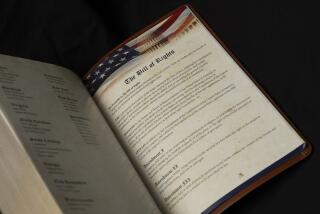The Word, Simply Said
- Share via
A new Bible written in colloquial Spanish is earning praise from pastors--but it faces a tough sell with Catholics, the largest denomination by far among Latinos.
Nueva Version Internacional, or NVI, is the first Bible ever translated by evangelical Latin Americans. It draws on the expertise of 20 biblical scholars from Colombia, Mexico, Argentina, Puerto Rico, Cuba, Ecuador and other nations across the Americas.
Painstakingly translated from Hebrew and Greek over the past decade, the Bible was launched in Southern California in February and now is being released to bookstores across the nation. In Orange County, the new Bible is just beginning to attract attention.
Pastor Johnny Lopez of Cristo Rey Hispanic Church in Orange ordered his own NVI Bible after reading a borrowed copy.
“It doesn’t employ those archaic terms, and it reads beautifully,” said Lopez, who is pleased that the Bible avoids the formal second-person-plural rarely used by Latinos in the United States.
The NVI edition seeks to dethrone the venerable Reina Valera, a Spanish translation of the Bible that is comparable to its influential English counterpart, the King James Version. Theologians have long complained that the language of Reina Valera is archaic.
“The language is a little bit simpler and that’s what a lot are looking for,” Robert Kleist, manager of House of Bibles in Fullerton, said about the NVI. He quickly sold out his initial order of six copies and ordered another dozen.
The new Bible is a $1.5-million project undertaken by the International Bible Society and published by a subsidiary of HarperCollins. It comes at a time when Spanish-language Bible sales are booming in this country, reflecting the increased size of the American Latino market.
“It’s the same word of God written in a language that people nowadays can understand,” said David Swindoll, editorial director of the publishing house, which is based in Miami.
Spanish-language Bibles are big business. Broadman and Holman Bible Publishing in Tennessee, the nation’s largest Bible publisher, has seen its Spanish Bible sales explode over the last five years to more than 4 million copies a year, said sales representative Margo Bradley.
The new Spanish-translation Bible, however, may not gain a large audience among Catholics, who make up most of the nation’s Latinos.
The new Bible does not include notes specific to Catholic Bibles included in popular Spanish translations such as the Latinoamericana Bible or the more scholarly Biblia de Jerusalem. These notes are necessary for a Bible to earn the Vatican’s seal of approval.
“People can buy whatever Bible they are inclined to, but I do know that Latino Catholics . . . will look for a Catholic Bible,” said Msgr. Jaime Soto, vicar for the Hispanic ministry of the Catholic Diocese of Orange.
Yet even if the book doesn’t gain a wide Catholic audience, the work will help biblical scholars, Soto said.
“This is a significant contribution to the task that we all share among churches to proclaim God’s word in a way that speaks to the ears of Latino men and women living in the modern age,” he said.
The target audiences for this book are mainly Protestants and others who have an interest in God and spirituality, Swindoll said. He added that it’s likely to sell better to young people because older ones may be set on their favorite translation.
Indeed, there are about 20 other Spanish-language translations of the Bible. Many have been criticized for paraphrasing so heavily into today’s Spanish that the accuracy of the ancient text has been lost.
The NVI’s aim is to strike a balance by capturing the poetry of books such as Psalms and Proverbs while retaining the readability of conversational Spanish.
That combination has gained the new Bible some fans. At a Los Angeles gathering in February held to introduce more than 120 evangelical pastors and church leaders from all denominations to the new Bible, participants such as the Rev. Obed Simite praised the NVI as a more effective educational tool for today’s Latino congregation.
“This is exactly what we needed,” said Simite, of Iglesia Bethel, a Pentecostal church in Pasadena. “It’s the first Bible translated by Latin Americans who understand our language and our customs. They’re like us. This is God speaking to us on a level we can comprehend.”
Still, publishers say cracking the respected Reina Valera’s market has so far proved almost impossible. The 1909 Reina Valera version has been updated twice by the United Bible Societies, in 1960 and 1995. The 1960 version remains the most popular among older Latino Christians and is used by more than 85% of all Spanish Protestant churches. Publishers predict it will continue to be the top seller into the next century.
It takes about seven years for a new Bible to gain acceptance, Bradley said.
“If a big leader like Billy Graham backs it, that’s the only time you’re sure it’s going to be a big hit,” she said.
After the launching in Los Angeles, backers of the new translation plan stops in New York, Chicago, Miami and Mexico City, as well as cities in Guatemala, Argentina and Colombia.
The International Bible Society is hoping that the Spanish NVI will sell as well as its English-language New International Version. Since its debut 20 years ago, that edition has sold more than 100 million copies.
Luciano Jaramillo, executive secretary of the Bible Society’s translation committee, said the NVI does not aim to replace the Reina Valera. He urged pastors to use it to complement their other biblical texts.
“There is no one perfect translation of the Bible,” Jaramillo said. “This shouldn’t be about competition. One should never spend their lives on one Bible alone.”
More to Read
Sign up for Essential California
The most important California stories and recommendations in your inbox every morning.
You may occasionally receive promotional content from the Los Angeles Times.










